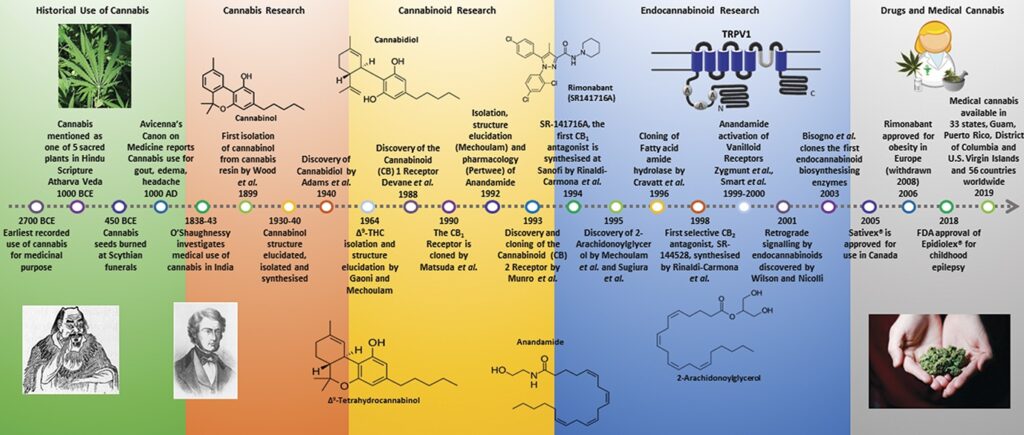What is the endocannabinoid system?
The endocannabinoid system (ECS) is a highly complex signaling system in our bodies. The ECS comprises an extensive network of various chemical signals, cellular receptors, and bodily systems. It’s basically the bridge between cannabis molecules, our body, and the various effects produced. The ECS is considered a neuromodulatory system, which means certain neurons use one or more chemicals to regulate a diverse and large number of other neurons. This chain reaction is a physiological process that begins with external cannabinoids entering the bloodstream. It modulates and controls a vast array of homeostatic functions, including:
- Learning and memory
- Sleep
- Temperature control
- Pain control
- Emotional processing
- Eating
- Inflammatory and immune response
Cannabis sativa’s cannabinoids give the plant its innate powers. Despite records going back as far as 4,700 years that document the medicinal use of cannabis, no one truly knew how it worked and why it produced certain effects – not until the late 1900s at least.
Cannabis sativa was first classified to contain psychoactive constituents in the 1960s. From here, research about its pharmacology and method of action began. Fast forward a couple decades to the late 80s/early 90s when researchers first discovered cannabinoid receptors in the brains of rats.

What Is The Structure of the Endocannabinoid System?
Just like our digestive or cardiovascular systems, the ECS is also a type of bodily system that regulates biological processes through producing physiological responses. For starters, the ECS must communicate with our bodies somehow; and like all systems, this somehow is through our nervous system. Our nervous system has two parts – Central Nervous System (CNS) and Peripheral Nervous System (PNS). Both the CNS and PNS are interconnected and constantly communicate with one another. The CNS includes the brain and spinal cord, whereas the PNS includes all of the nerves that branch out and extend into other tissues, organs, and muscles. The endocannabinoid system permeates all 11 central physiological systems in the body
Cannabinoids, such as THC and CBD, are molecules produced by a cannabis plant. Whereas endocannabinoids are the substances naturally produced by our bodies that respond to cannabinoids by stimulating receptors. The endocannabinoid system (ECS) consists chiefly of CB1 and CB2 (receptors), AEA and 2-AG (endocannabinoids), and enzymes.
Let’s take a closer look at the ECS’s key players so that we can understand just how the ECS works.

Cannabinoid Receptors
Throughout the nervous systems’ connective network you can find cannabinoid receptors, known as CB1 and CB2. CB1 receptors are mainly found in the CNS, although they also exist outside the CNS. Whereas CB2 receptors are primarily found outside of the CNS and play an important role with the immune system. Many tissues and bodily systems contain both CB1 and CB2 receptors, thus making the range of their effects widespread. Researchers have theorized that there may be a third cannabinoid receptor, but we’ll leave that for a different blog.
Both CB1 and CB2 belong to a family of receptors called G-protein coupled receptors. These receptors are embedded in the cell membrane and are able to directly influence incoming signals. CB1/CB2 receptors are actually believed to be more plentiful than any other kind of receptor system.
CB1 receptors are densely located in brain regions such as the neocortex, hippocampus, basal ganglia, amygdala, striatum, cerebellum, and hypothalamus. These sections of our brains mediate a wide variety of high-order behavioral functions, including: learning and memory, executive function decision making, sensory and motor responsiveness, and emotional reactions, as well as feeding and other homeostatic processes.
By contrast, CB2 receptors are mostly found in immune cells, such as lymphocytes, neutrophils, leukocytes, and B cells.
Endocannabinoids
The two most well understood endocannabinoids in the human body are anandamide and 2-arachidonoylglycerol. Both anandamide and 2-arachidonoylglycerol are endogenous agonists, meaning they have the primary purpose of stimulating and activating CB1 and CB2 receptors. They’re the drill sergeants that wake everyone up. They keep the ECS running smoothly and are only produced by our bodies when needed – aka when you consume cannabis.
Anandamide (AEA) is dubbed as the “bliss molecule”, with its root “ananda” being a Sanskrit word for “happiness, pleasure, joy, and delight”. It was also the first endocannabinoid to be discovered. AEA is a high-affinity, partial agonist for CB1 receptors with very low activity at CB2 receptors.
2-arachidonoylglycerol (2-AG) is the most abundant endocannabinoid in the body. It is primarily responsible for managing appetite, pain response, and immune functions. 2-Ag is a full agonist for both CB1 and CB2 receptors, with moderate to low affinity.
Cannabinoids
The ECS performs as a key-lock model. The cannabinoids act as the keys within the ECS, while receptors act like locks. THC and CBD are exogenous cannabinoids, meaning they originate from outside of the body. They are also referred to as phytocannabinoids, meaning they come from plants.
Exogenous cannabinoids act similarly to endocannabinoids. THC agonizes both CB1 and CB2 receptors, whilst CBD preferentially agonizes CB2 receptors. THC has psychoactive side-effects which CBD completely lacks. The chemical structure of THC is similar, but not identical to, AEA whereas CBD more closely mimics 2-AG.
Enzymes
Enzymes act within the ECS to recycle used endocannabinoids once the body is done with them. These enzymes include fatty acid amide hydrolase and monoacylglycerol acid lipase. Fatty acid amide hydrolase breaks down AEA, and monoacylglycerol acid lipase typically breaks down 2-AG.
So once you consume cannabis, in whatever form that may be, cannabinoids have officially entered your bloodstream and activated your nervous system via the help of AEA and 2-AG, CB1 and CB2.
The Endocannabinoid System’s Role in….
So now that we know the key elements that makeup the ECS, we can now look at the overall role of this system and how it affects other bodily operations. The ECS plays a wide role in a variety of different systems and processes. A few worth noting are: learning and memory, epilepsy, and the entourage effect theory.
Learning and Memory
It’s widely presumed that partaking in cannabis consumption will cause you to have a poor memory. However, the ECS has many ways in which it regulates brain operations related to memory processing and neuronal activity. The memory-related effects induced by the cannabinoids truly depends on the kind of cannabinoid compound used, dosage, and route of administration as well as on the memory task chosen. Therefore contrary to popular belief, there are an array of varying factors that simultaneously play a part. This seems to be a recurring theme in most endocannabinoid research articles as well, for most researchers end their articles as inconclusive – meaning that further research must be conducted.
Epilepsy
Cannabis products are commonly used for the treatment of epilepsy and seizure control. The mechanism behind cannabis being an effective remedy lies within the ECS. The CB1 receptors actually inhibit the release of seizure causing neurotransmitters, known as GABA and glutamate. This mechanism is known as CB1R-mediated neuroprotection against excitotoxicity – a known pathological process in both epilepsy and neurodegenerative disorders. This discovery of the link between the endocannabinoid system and how it can help treat biological ailments is the sheer purpose of cannabis research.
The Entourage Effect
As you can see, cannabis is not a single compound product but is known for its complicated molecular profile. It produces a plethora of cannabinoids alongside a vast array of other secondary molecules, such as terpenes and flavonoids. The Entourage Effect is a term used to describe the synergistic effects of cannabinoids, such as CBD and THC, with various other compounds. In 2001, two highly notable researchers John McPartland and Ethan Russo, published a paper entitled, “Cannabis and Cannabis Extracts: Greater Than the Sum of Their Parts”. This research paper more closely examines how cannabinoids act with secondary compounds, such as terpenes and flavonoids. Their research found supporting evidence that extracts rich in both cannabinoids and terpenes actually increased pharmacological activities that strengthened and broadened clinical applications and improved the therapeutic index. To summarize, terpenes enhance the effects of cannabinoids, and having terpenes intact with cannabinoids shows a noticeable difference in effects.

Only the beginning
Although cannabis research has been going on for a few decades now, it’s still only the beginning for this plant. There are over 120 different cannabinoids present in cannabis, yet we only really hear about THC or CBD. With laws and regulations changing, more research will be able to be conducted. With that being said, the future of cannabis science and how it interacts with our endogenous endocannabinoid system will only continue to be better understood. The goal is to ultimately unveil hidden truths within both the chemistry of the plant and ourselves. Understanding how the two communicate with each other will aid in the quality of biological life.
Sources:
https://www.health.harvard.edu/blog/the-endocannabinoid-system-essential-and-mysterious-202108112569
https://www.healthline.com/health/endocannabinoid-system#deficiency
https://www.ncbi.nlm.nih.gov/pmc/articles/PMC3997295/
https://www.jyi.org/2018-june/2018/6/1/the-endocannabinoid-system-our-universal-regulator
https://www.blisscafeslo.com/bliss-blog/2021/10/26/bliss-hemp-the-endocannabinoid-system



 Modern Canna
Modern Canna